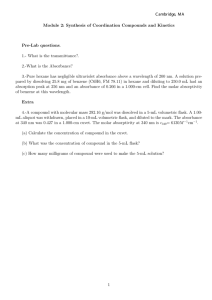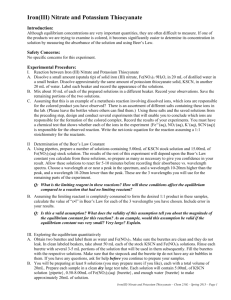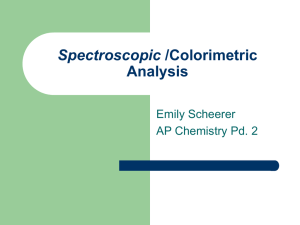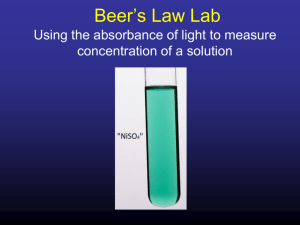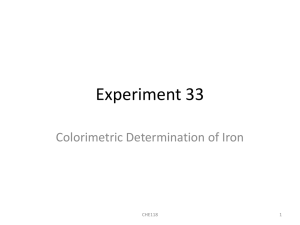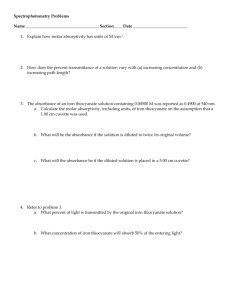– THIOCYANATE THE IRON(III) REACTION SYSTEM Experiment 7
advertisement
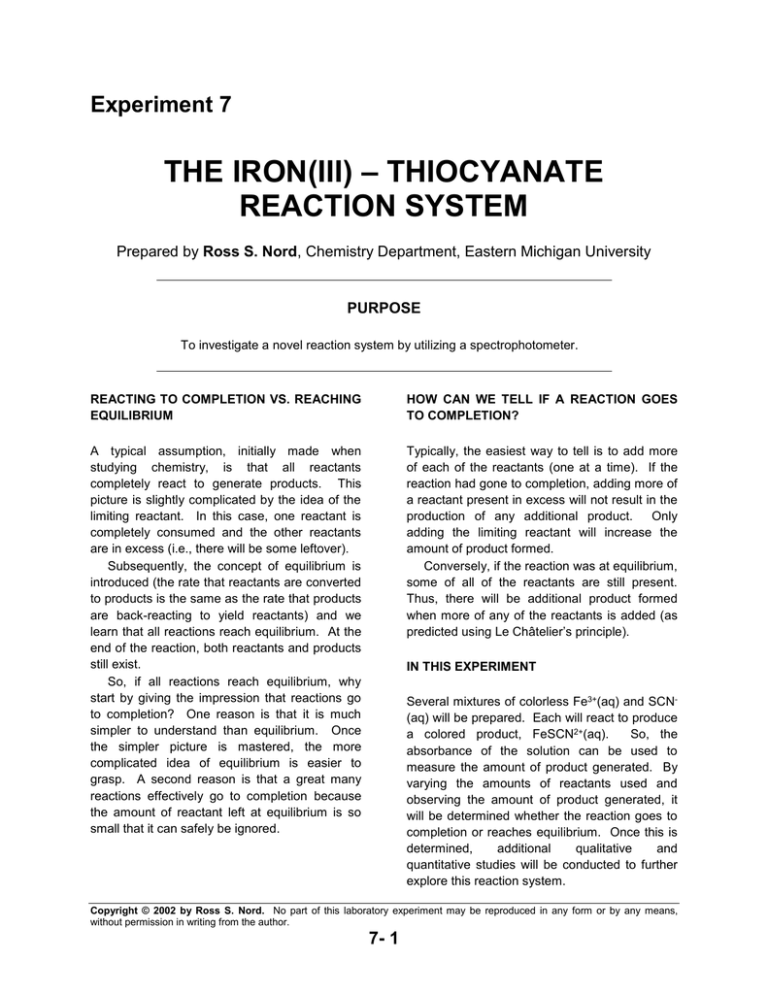
Experiment 7 THE IRON(III) – THIOCYANATE REACTION SYSTEM Prepared by Ross S. Nord, Chemistry Department, Eastern Michigan University PURPOSE To investigate a novel reaction system by utilizing a spectrophotometer. REACTING TO COMPLETION VS. REACHING EQUILIBRIUM HOW CAN WE TELL IF A REACTION GOES TO COMPLETION? A typical assumption, initially made when studying chemistry, is that all reactants completely react to generate products. This picture is slightly complicated by the idea of the limiting reactant. In this case, one reactant is completely consumed and the other reactants are in excess (i.e., there will be some leftover). Subsequently, the concept of equilibrium is introduced (the rate that reactants are converted to products is the same as the rate that products are back-reacting to yield reactants) and we learn that all reactions reach equilibrium. At the end of the reaction, both reactants and products still exist. So, if all reactions reach equilibrium, why start by giving the impression that reactions go to completion? One reason is that it is much simpler to understand than equilibrium. Once the simpler picture is mastered, the more complicated idea of equilibrium is easier to grasp. A second reason is that a great many reactions effectively go to completion because the amount of reactant left at equilibrium is so small that it can safely be ignored. Typically, the easiest way to tell is to add more of each of the reactants (one at a time). If the reaction had gone to completion, adding more of a reactant present in excess will not result in the production of any additional product. Only adding the limiting reactant will increase the amount of product formed. Conversely, if the reaction was at equilibrium, some of all of the reactants are still present. Thus, there will be additional product formed when more of any of the reactants is added (as predicted using Le Châtelier’s principle). IN THIS EXPERIMENT Several mixtures of colorless Fe3+(aq) and SCN(aq) will be prepared. Each will react to produce a colored product, FeSCN2+(aq). So, the absorbance of the solution can be used to measure the amount of product generated. By varying the amounts of reactants used and observing the amount of product generated, it will be determined whether the reaction goes to completion or reaches equilibrium. Once this is determined, additional qualitative and quantitative studies will be conducted to further explore this reaction system. Copyright © 2002 by Ross S. Nord. No part of this laboratory experiment may be reproduced in any form or by any means, without permission in writing from the author. 7- 1 Experiment 7 – The Iron(III) – Thiocyanate Reaction System PRE-LABORATORY PREPARATION 1. Read the background, procedure, and data analysis sections of the experiment. 2. Complete the computer-generated PRELAB assignment. Refer to your textbook and the various sections of the experiment as needed. EXPERIMENTAL SECTION REAGENTS PROVIDED (c) Insert the blank cuvet, containing distilled water. (d) Click on Finish Calibration, then click OK. Fe(NO3)3(aq), 0.010 M. This is prepared using 0.10 M HNO3 as the solvent, since the acid stops insoluble iron hydroxides from forming. KSCN(aq), 0.010 M. HCl(aq), 1.0 M. KSCN(s) and KNO3(s). 2. Click on the Configure Spectrometer icon and then click on Abs vs. Time. This changes the data collection mode so that a single wavelength can be selected. 3. Choose to monitor absorbance at 470 nm. LoggerPro defaults to the wavelength of maximum absorbance, max. On the list of wavelengths in the dialog box click to unselect max and then click on 470 nm (or the available wavelength closest to 470 nm). The complex ion formed during the reaction is red/orange, so it most readily absorbs blue light. We have the literature value for the molar absorptivity at 470 nm, so we will use it. Hazardous Chemicals 0.010 M Fe(NO3)3(aq) and 0.010 M KSCN(aq) are both toxic and irritants. Wash thoroughly if you come into contact with either solution. WASTE DISPOSAL PREPARATION OF SOLUTIONS All solutions should be discarded into a waste container in the hood. 4. Pour 60 mL of stock iron(III) nitrate into a clean, dry 100-mL beaker. Record the actual concentration of the Fe(NO3)3 on your Data Sheet. PROCEDURE Unless told otherwise, you will work with a partner (or two, if necessary). 5. Pour 60 mL of stock potassium thiocyanate into a clean, dry 100-mL beaker. Record the actual concentration of the KSCN on your Data Sheet. SETUP THE SPECTROPHOTOMETER 1. Attach the SpectroVis spectrophotometer, start LoggerPro, and calibrate as follows: (a) Click on Experiment, then Calibrate… , then Spectrometer: 1. (b) Allow the spectrometer to warm up. 6. Rinse out a 100-mL volumetric flask with distilled water. It is not necessary to dry the flask since more water will be added later. 7- 2 Experiment 7 – The Iron(III) – Thiocyanate Reaction System 7. Pipet 5.00 mL of the iron(III) nitrate(aq) into the clean 100-mL volumetric flask. Remember to rinse the pipet with the iron(III) nitrate solution first. Use a 250-mL beaker as a temporary waste beaker to hold the rinsings. DETERMINATION OF REACTION TYPE 13. Answer Data Analysis question 1. If you decide that the reaction in solution 1 is at equilibrium, follow the steps below under EQUILIBRIUM. If you decide that the reaction has gone to completion, follow the steps below under COMPLETION. 8. Pipet 5.00 mL of KSCN(aq) into the same volumetric flask. EQUILIBRIUM (Skip if your reaction went to completion) 9. Fill the volumetric flask to the line with distilled water, cap it, and then mix thoroughly (by inverting several times). Label this as solution 1. 14. Create an ice-water bath by filling a 50mL beaker with ice and adding water until the liquid level is about halfway up the beaker. 10. Rinse a cuvet once with distilled water and then three times with solution 1. The waste from the rinsings can be poured into the 250-mL beaker. In fact, it is best to hold the cuvet and volumetric flask over the waste beaker while pouring solution into the cuvet. 15. Remeasure and record (in the data table under Equilibrium) the absorbance of the cuvet containing solution 1. We will be remeasuring the absorbance of each solution immediately before modifying it, as sometimes the absorbance will drift with time. 11. Fill the cuvet with the solution you just prepared, dry the outside with a Kimwipe, and then measure its absorbance at 470 nm. Record the absorbance on your data sheet to the nearest 0.001. Set the volumetric flask and cuvet aside for possible later use. Do not discard the solution yet. Hint: if the absorbance is less than 0.100 then either the spectrometer needs to be recalibrated or the solution was not prepared properly. Redo it or get help as needed. 16. Immerse the cuvet containing solution 1 into the ice-water bath for two minutes. Dry the outside using a Kimwipe, and then measure and record its absorbance. 17. Remeasure and record the absorbance of unmodified solution 2. 12. Repeat steps 6-11 for solutions 2-4 using the amounts of iron(III) nitrate and potassium thiocyanate found in Table 1. Label each solution and do not discard any of the solutions, even after the absorbance has been measured. 18. Add one BB-sized (2-3 mm diameter) crystal of KNO3 to the volumetric flask containing solution 2. Cap and invert the flask several times to dissolve the crystal. The exact size of the crystal is not critical. However, a smaller crystal will dissolve faster. Do not refill the flask or add any additional distilled water. Table 1. Solution compositions. solution Volume of Volume of number Fe(NO3)3 (mL) KSCN (mL) 19. Rinse and fill a cuvet with the modified solution 2. Measure & record its absorbance. 1 2 3 4 5.00 10.00 5.00 10.00 5.00 5.00 10.00 10.00 20. Remeasure and record the absorbance of unmodified solution 3. 7- 3 Experiment 7 – The Iron(III) – Thiocyanate Reaction System 21. Add one BB-sized (2-3 mm diameter) crystal of KSCN to the volumetric flask containing solution 3. Cap and invert the flask several times to dissolve the crystal. Again, the exact crystal size is not critical and do not refill the flask. 27. Prepare a hot water bath by adding 200 mL of hot tap water to a 400-mL beaker. Run the hot water until it is as hot as it can get. This can take a couple of minutes. Caution: the water can get very hot so be careful not to burn yourself. 22. Rinse and fill a cuvet with the modified solution 3. Measure & record its absorbance. 28. Immerse the volumetric flask containing solution 5 into the hot water bath and let it sit for 10 minutes. After 10 minutes fill a clean cuvet with the solution and measure its absorbance. Typically, a reaction’s rate is affected by temperature (as it will speed up at higher temperatures). This step is designed to test whether or not the yield is also affected. 23. Remeasure and record the absorbance of the cuvet containing solution 4. 24. Add two drops of 1.0 M HCl to the cuvet containing solution 4. Put a cap on the cuvet and invert it several times to mix. Measure and record the absorbance of this solution. CLEAN UP Skip to the Clean-Up section below. 29. Dump all of the waste solutions from the cuvets, volumetric flasks, and 250-mL beaker into a waste container in the hood. COMPLETION (Skip if your reaction reached equilibrium) 30. Rinse all of your glassware with distilled water. Dry it and return it to the drawer(s). 25. Prepare solution 5 by pipetting 15.00 mL of each reactant into a 100-mL volumetric flask and filling it with distilled water. 31. Wash your hands before leaving lab. 26. Rinse and fill a cuvet with solution 5. Measure the absorbance of this solution and record it on your data sheet. 7- 4 Experiment 7 – The Iron(III) – Thiocyanate Reaction System Name Station Used Instructor/Day/Time _ Partner Partner Station Checked & Approved DATA SHEET Be sure to record all data with the proper number of significant figures (and units when needed). Concentration of the stock Fe(NO3)3 solution: _________________________ Concentration of the stock KSCN solution: _________________________ Volumes Used and Absorbances for the Four Solutions Prepared: Volume of Fe(NO3)3 Used (mL) Volume of KSCN Used (mL) Solution 1 5.00 5.00 Solution 2 10.00 5.00 Solution 3 5.00 10.00 Solution 4 10.00 10.00 Absorbance Equilibrium: (Skip this section if your reaction went to completion) Unmodified Absorbance Cooled/Modified Absorbance Solution 1 Solution 2 Solution 3 Solution 4 Completion: (Skip this section if your reaction reached equilibrium) Solution 5 Volume of Fe(NO3)3 Used (mL) Volume of KSCN Used (mL) 15.00 15.00 Solution 5 heated 7- 5 Absorbance Experiment 7 – The Iron(III) – Thiocyanate Reaction System DATA ANALYSIS All calculations should be clearly organized, make proper use of significant figures, and include the units. 1. Decide whether the reaction in solution 1 goes to completion or reaches equilibrium. (a) Compare the absorbances for solutions 1 & 2. Did the amount of product produced significantly increase (by more than 25%) when the concentration of Fe(NO 3)3 is doubled? (Recall that the absorbance is proportional to the concentration of product.) (b) Compare the absorbances for solutions 1 & 3. Did the amount of product produced significantly increase (by more than 25%) when the concentration of KSCN is doubled? (c) Based upon your answers to questions (a) and (b), decide if the reaction has a limiting reactant. If so, the reaction has gone to completion, if not, the reaction has reached equilibrium. Circle the appropriate choice below: [Review the background material on the first page of the experiment and then chat with the instructor, if necessary, if you are uncertain.] The reaction went to completion The reaction reached equilibrium 2. Theoretically, if a reaction goes to completion and one reactant is in large excess, is it possible for the answers to questions 1(a) and 1(b) to both be no? If so, explain how. EQUILIBRIUM (Skip this section if your reaction went to completion) 3. Circle your choices from the pairs provided in the following statement: Submerging solution 1 in an ice bath caused the absorbance to (increase, decrease) meaning that the concentration of product (increased, decreased). This implies that the equilibrium shifted to favor the (reactants, products) meaning that heat is a (reactant, product) in this reaction. Therefore, this reaction is (endothermic, exothermic). As the temperature increases, the value of Kc for this reaction will (increase, stay the same, decrease). 4. Calculate Kc for the reaction, using the solution 1 room-temperature data, following steps (a-e): (a) Calculate the concentration of product formed in solution 1 using Beer’s Law (A=bc, b=1.00 cm), its measured absorbance (at room temperature), and a molar absorptivity of 4.80 x 103 cm-1 M-1. 7- 6 Experiment 7 – The Iron(III) – Thiocyanate Reaction System (b) Use the concentration of the stock Fe(NO3)3 provided, and the volume used, to perform a dilution calculation and determine the initial concentration of Fe3+ in the 100-mL volumetric flask. (c) Calculate the initial concentration of SCN- in solution 1 by repeating step (b) for KSCN. (d) In the table below, insert your answers for parts (b) and (c) for the initial concentrations of reactants and insert your answer to part (a) for the equilibrium concentration of product. Complete the table. Fe3+(aq) Net ionic reaction: SCN-(aq) + (b) ⇌ FeSCN2+(aq) (c) Initial (M) 0 Change (M) (a) Equilibrium (M) (e) Use the equilibrium concentrations of the three species to calculate Kc for the reaction. 7- 7 Experiment 7 – The Iron(III) – Thiocyanate Reaction System 5. Solid potassium nitrate was added to solution 2. (a) Write the formulas (including charges) of the ions formed when KNO3 dissolves. (b) When the KNO3 was added to solution 2, did the absorbance change significantly (more than 25%)? (c) If so, briefly explain which ion is affecting the equilibrium and how. If not, give the general name assigned to ions that are present in a solution but not participating in a reaction. 6. Solid potassium thiocyanate was added to solution 3. (a) Write the formulas (including charges) of the ions formed when KSCN dissolves. (b) When the KSCN was added to solution 3, did the absorbance change significantly (more than 25%)? (c) If so, briefly explain which ion is affecting the equilibrium and how. If not, give the general name assigned to ions that are present in a solution but not participating in a reaction. 7. Adding HCl, to solution 4, affects the equilibrium because FeCl4- is a stable complex ion that can form from Fe3+ and Cl- in aqueous solution. (a) Should the [Fe3+] in the cuvet initially increase or decrease when the HCl is added? (b) As the [Fe3+] changes as predicted in part (a), what effect should this have on the [FeSCN2+]? (Refer to the reaction given in question 4(d) and consider Le Châtelier’s principle.) (c) As the [FeSCN2+] changes as predicted in part (b), what effect should this have on the absorbance? (d) Did your experimental absorbance change as predicted in part (c)? If not, resolve the discrepancy. 7- 8 Experiment 7 – The Iron(III) – Thiocyanate Reaction System COMPLETION (Skip this section if your reaction reached equilibrium) 8. Based upon the absorbances of solutions 1, 2, & 3, which of the two reactants is the limiting reactant? Fully explain how you decided which one is limiting. 9. If the limiting reactant is Fe(NO3)3 the reaction should have gone to completion in solution 3. If the limiting reactant is KSCN the reaction should have gone to completion in solution 2. The amount of limiting reactant, and the absorbance, can be used to calculate the molar absorptivity of the product. (a) For the solution where the reaction went to completion, what volume of limiting reactant was used? (b) Use the concentration of the stock limiting reactant solution provided to perform a dilution calculation and determine the concentration of limiting reactant in the 100-mL volumetric flask. (c) Assuming that one mole of the product forms for each mole of limiting reactant used, the answer to part (b) is also the concentration of the product that formed. Use this concentration, the measured absorbance, and Beer’s Law (A=bc, b=1.00 cm) to determine the molar absorptivity of the product. 7- 9 Experiment 7 – The Iron(III) – Thiocyanate Reaction System 10. In solution 5, the concentration of the limiting reactant was approximately tripled and so the concentration of product obtained should be tripled as well. (a) Using the molar absorptivity just determined, and the absorbance of solution 5, calculate the concentration of product obtained in solution 5. (b) From the volume of limiting reactant used, calculate the expected concentration of product in solution 5 (following the same procedure as in questions 9(a) and (b), above). (c) Calculate the % yield by dividing the actual concentration obtained in step (a) by the expected concentration calculated in step (b) and multiply by 100%. (d) If your percent yield is less than 90% or greater than 110%, explain what might cause this deviation. 11. The effect of temperature on the yield of product. (a) Based upon the absorbance of solution 5 after it had sat in the hot water bath, does the yield of product increase or decrease with temperature? (b) Calculate the % yield at the higher temperature. 7- 10
